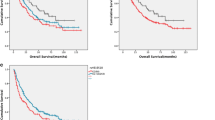Abstract
A disintegrin and metalloproteinase with thrombospondin motifs 5 (ADAMTS5) is considered to be an important anti-angiogenic protein, in which the first TSR domain is crucial for its anti-angiogenic activity. Previous study showed that ADAMTS5 plays a role in suppression of hepatocellular carcinoma (HCC) progression through its anti-angiogenic activity. The rs2380585 G>A single-nucleotide polymorphism (SNP) is a missense mutation, located in the ADAMTS5 first TSR domain coding sequence (CDS). In this study, we investigated the impacts of ADAMTS5 rs2380585 polymorphism on the risk and progress of hepatocellular carcinoma. A total of 220 HCC patients and 220 controls in a Chinese Han population were enrolled and genotyped. The associations between SNPs and HCC incidence and progression were analyzed with logistic regression model. We found that individuals with the ADAMTS5 rs2380585 A allele was significantly associated with decreased HCC risk (OR = 0.348, 95 % CI 0.236–0.512; p = 0.000). Individuals having the ADAMTS5 rs2380585 polymorphic genotype (GA+AA) had an OR of 0.348 (95 % CI 0.201–0.600; p = 0.000) for developing HCC, compared with individuals having the ADAMTS5 rs2380585 ancestral genotype. However, stratified analyses did not find any evident gene–covariates interaction. The SNP of rs2380585 was irrelevant to the frequencies of clinicopathological characteristics. Our results for the first time indicate that ADAMTS5 rs2380585 polymorphism contributes to HCC susceptibility.
Similar content being viewed by others
References
Ferlay, J., et al. (2010). Estimates of worldwide burden of cancer in 2008: GLOBOCAN 2008. International Journal of Cancer, 127(12), 2893–2917.
Yano, Y., et al. (2006). Clinical features of hepatitis C virus-related hepatocellular carcinoma and their association with alpha-fetoprotein and protein induced by vitamin K absence or antagonist-II. Liver International, 26(7), 789–795.
Firpi, R. J., & Nelson, D. R. (2006). Viral hepatitis: Manifestations and management strategy. American Society of Hematology American Society of Hematology Education Program, 1, 375–380.
Mikhail, S., Cosgrove, D., & Zeidan, A. (2014). Hepatocellular carcinoma: Systemic therapies and future perspectives. Expert Review of Anticancer Therapy, 14(10), 1205–1218.
Feitelson, M. A. (2006). Parallel epigenetic and genetic changes in the pathogenesis of hepatitis virus-associated hepatocellular carcinoma. Cancer Letters, 239(1), 10–20.
Shastry, B. S. (2002). SNP alleles in human disease and evolution. Journal of Human Genetics, 47(11), 561–566.
Buendia, M. A. (2000). Genetics of hepatocellular carcinoma. Seminars in Cancer Biology, 10(3), 185–200.
Kintakas, C., & McCulloch, D. R. (2011). Emerging roles for ADAMTS5 during development and disease. Matrix Biology, 30(5–6), 311–317.
Stanton, H., et al. (2005). ADAMTS5 is the major aggrecanase in mouse cartilage in vivo and in vitro. Nature, 434(7033), 648–652.
Held-Feindt, J., et al. (2006). Matrix-degrading proteases ADAMTS4 and ADAMTS5 (disintegrins and metalloproteinases with thrombospondin motifs 4 and 5) are expressed in human glioblastomas. International Journal of Cancer, 118(1), 55–61.
Cross, N. A., et al. (2005). The expression and regulation of ADAMTS-1, -4, -5, -9, and -15, and TIMP-3 by TGFbeta1 in prostate cells: relevance to the accumulation of versican. Prostate, 63(3), 269–275.
Porter, S., et al. (2004). Dysregulated expression of adamalysin-thrombospondin genes in human breast carcinoma. Clinical Cancer Research, 10(7), 2429–2440.
Kumar, S., et al. (2012). ADAMTS5 functions as an anti-angiogenic and anti-tumorigenic protein independent of its proteoglycanase activity. American Journal of Pathology, 181(3), 1056–1068.
Sharghi-Namini, S., et al. (2008). The first but not the second thrombospondin type 1 repeat of ADAMTS5 functions as an angiogenesis inhibitor. Biochem Biophys Res Commun, 371(2), 215–219.
Yue, P., Melamud, E., & Moult, J. (2006). SNPs3D: candidate gene and SNP selection for association studies. BMC Bioinformatics, 7, 166.
Rodriguez-Lopez, J., et al. (2008). Genetic variation including nonsynonymous polymorphisms of a major aggrecanase, ADAMTS-5, in susceptibility to osteoarthritis. Arthritis and Rheumatism, 58(2), 435–441.
Peng, Y., et al. (2014). Association of DNA base excision repair genes (OGG1, APE1 and XRCC1) polymorphisms with outcome to platinum-based chemotherapy in advanced nonsmall-cell lung cancer patients. International Journal of Cancer, 135(11), 2687–2696.
Sunyaev, S., et al. (2001). Prediction of deleterious human alleles. Human Molecular Genetics, 10(6), 591–597.
Liu, Q., et al. (2014). Long noncoding RNA related to cartilage injury promotes chondrocyte extracellular matrix degradation in osteoarthritis. Arthritis Rheumatol, 66(4), 969–978.
Zhang, J., et al. (2014). Transcriptional control of PAX4-regulated miR-144/451 modulates metastasis by suppressing ADAMs expression. Oncogene. doi:10.1038/onc.2014.259.
Acknowledgments
This study was supported in part by a Grant from the National Natural Science Foundation of China (No. 30872975 and No. 81270482).
Conflict of interest
The authors declared that there is no conflict of interest in this work.
Author information
Authors and Affiliations
Corresponding authors
Rights and permissions
About this article
Cite this article
Li, C., Xiong, Y., Zhong, Z. et al. Association Between a Variant in ADAMTS5 and the Susceptibility to Hepatocellular Carcinoma in a Chinese Han Population. Cell Biochem Biophys 72, 221–225 (2015). https://doi.org/10.1007/s12013-014-0441-3
Published:
Issue Date:
DOI: https://doi.org/10.1007/s12013-014-0441-3




